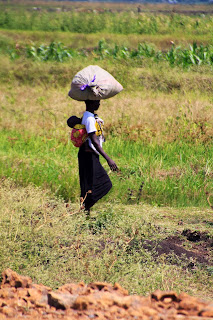When I had returned from my last trip a mutual friend of Carol Cruickshank and mine gave me a card. It had PINCC in large letters and had Carol’s name and contact information. I had not seen Carol for many years and had only heard about her briefly through our friend so I had no idea what she was up to and certainly had never heard of PINCC before. So I did what we all do these days and got on line to investigate.
I was intrigued by the idea of working with an organization supported and coordinated by someone like Carol. I had always known her to be a compassionate and unselfish person who had spent much of her life in the service of others. I was also excited about the idea of working specifically with African women. As amazing and beautiful as East Africa is it is the people that draw me. My internet search lead me to a U tube video of women singing out their gratitude to PINCC as they stood waiting in line to be screened. That was the all it took and I decided that I would contact Carol right away to investigate becoming a volunteer.
Approximately 1 year later I met with my first PINCC group in Bungoma, Kenya. I had already been traveling for several weeks in Uganda visiting Hospice and seeing friends. I arrived a couple days early so had a chance to check out the town. Like many East African towns Bungoma was bustling with street life. Cars, matatus, boda bodas and what I call boda bikes (transport of people on a padded seat on the back of a bicycle). Window shopping is easy in East Africa because the clothing shops display their cloths on wire hangers that express the cultural appreciation for women being well rounded from the waste down.
Our hotel was peaceful with a friendly staff. I was touched when it was time to go that they genuinely seemed sorry to see us leave. And despite a few kinks in the plumbing, a few holes in the mosquito netting and that toilet paper was hard to come by, it was a pleasant place to stay.
But of course the highlight was what we all came for, saving women’s lives with cervical cancer screening. One of the things that attracted me to PINCC in particular was the fact that it isn't just a group that comes in, rescues Africans and then departs leaving them with a vague memory of the experience and no ongoing skills. PINCC teaches the screening itself, even providing supplies and sometimes expensive equipment such as cryotherapy and LEEP machines. I was also so impressed with the other volunteers. Doctors, nurses and support people who have not only spent the time and money to be here but do their work with grace and compassion. I watched the doctors patiently and gently teaching the many different personalities that made up the doctors, nurses and medical officers from each site who are all so eager to learn how to make cervical cancer screening available to the women in their country.
Our second site was Kibera, one of the largest slums in East Africa. Each morning we would trade our shoes for rubber boots to make the 20 minute or so walk to the clinic. It had been raining (and a downpour in Kenya is very impressive) which made the narrow passageways through the slum more difficult, as the last thing anyone wanted to do was slip and fall into the mud here. We also had to be mindful of our heads as low metal roof overhangs were abundant. But the walk and the emotional experience of Kibera itself were all worth it when we encountered the enthusiastic group of healthcare providers waiting for us.
I have to say, that as I had thought, it was the women themselves who impressed me the most. Many of them had never seen a health care provider before and certainly most of them had never undergone a pelvic exam. Many of them were truly frightened but they overcame their fears and came in numbers. My favorite job while volunteering was when I had the opportunity to teach about cervical cancer. Generally this was done with an interpreter. Often a woman herself waiting to be screened who spoke English. I also found it very rewarding to explain to a woman what to expect from the process of screening itself in hope of easing her fear. But despite everyone’s best effort at preparation there was still some fear and in this case a hand to hold and a soothing voice became the necessity of the moment.
Gently, firmly with humility and much grace, Carol, our fearless leader kept us all on track. It was such a great experience getting to work with this amazing woman. She was truly the conductor of the orchestra and there would have been no music without her.
Volunteering with PINCC will always be a highlight, not only in my career as a nurse, but my life in general. It was a profound and rewarding experience and I am forever grateful to all the courageous, compassionate PINCC volunteers that I worked with. It was a true honor to be counted among you. AND I will see you again!











